Affiliate disclosure: This post may contain affiliate links. Please see our Privacy Policy.
Haskap Wine is a rich, homemade fruit wine that’s perfect for northern gardeners. Haskaps are hardy fruits that can withstand temperatures much colder than grapes, and the wine tastes surprisingly like a full-bodied red. (Haskaps are also called “Honeyberries,” and many people call this “Honeyberry Wine.”)
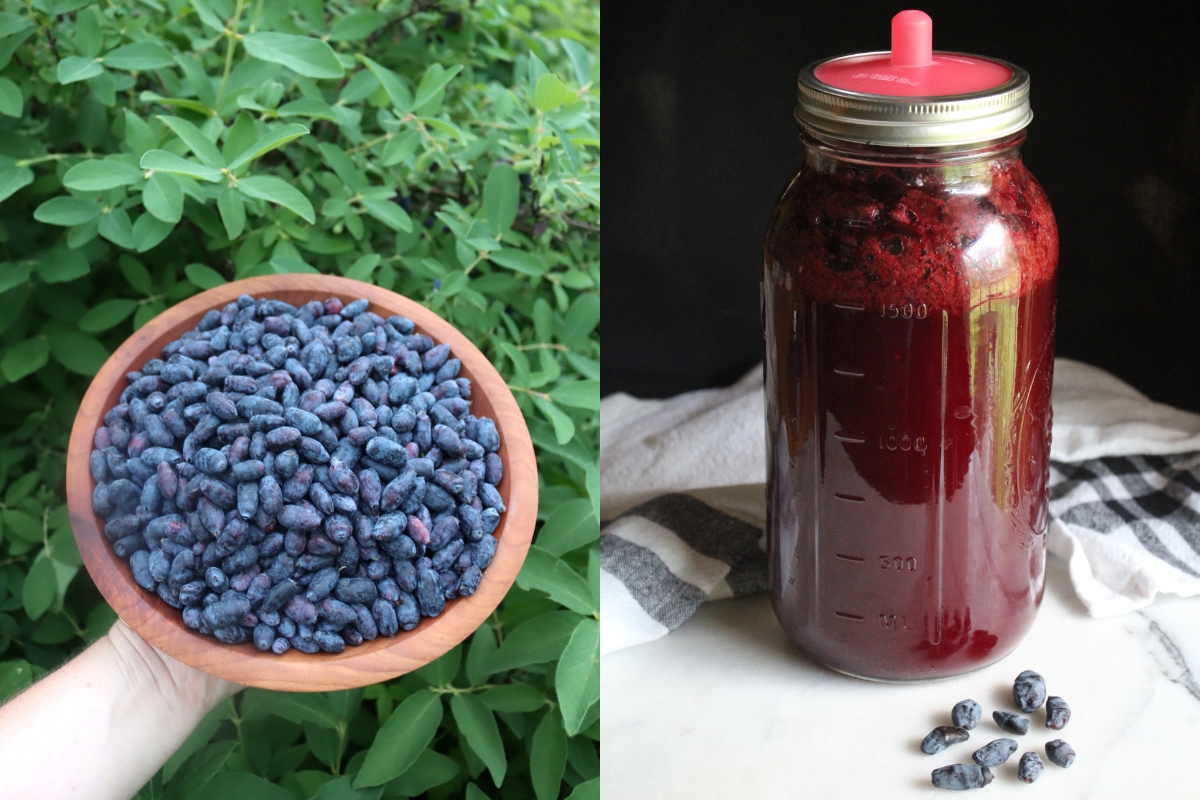
Collect those haskap berries in early summer to craft a wine with a deep burgundy color and delicious flavor. For something truly unique, use honey instead of sugar to yield a tasty haskap mead.
Haskap berries begin to appear in the spring. The shrubs tend to blossom in May with the fruit being ready for harvest about 2 months later, often found in late June and early July in most areas.
Haskaps, also known as honeyberries or blue honeysuckle, can be difficult to find, although you may luck out and find some in a local farmers market if you’re fortunate enough. You can grow honeyberries yourself, as the plants are hardy with many different varieties available that are suited to different areas of the U.S.
Haskap berries are a newer berry to the U.S. Originally native to northern Eurasia and Canada, there are many varieties including Japanese and Russian types.
Different varieties of haskap berries will produce different-tasting wines. Honeyberry USA found that Tundra haskaps produced a smooth wine with a nice aftertaste while the Indigo Gem variety created a more complex wine. Borealis haskaps lent the wine an especially fruity profile.
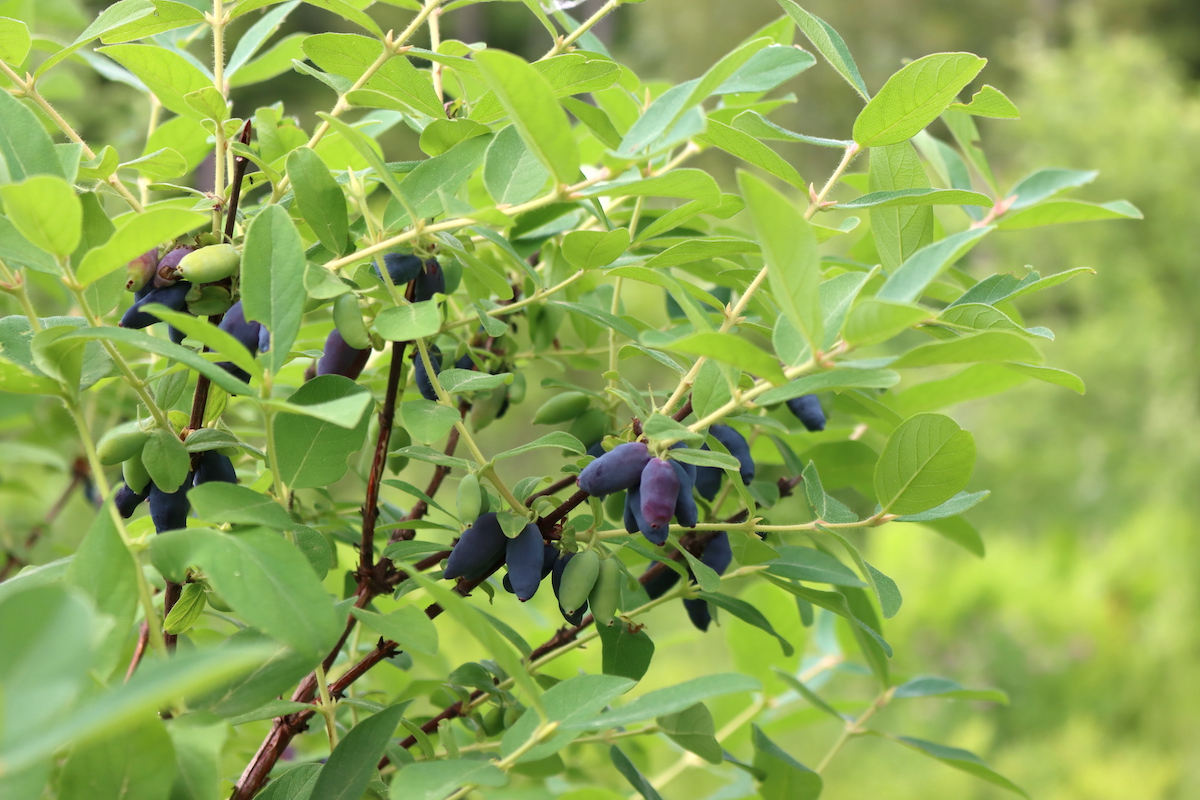
Any variety of haskap is suitable for winemaking though, and the individual flavors of your particular fruit will impart their own characteristics to your wine.
To make haskap wine, you’ll follow the same simple process as with making any small-batch country wine.
You’ll include the crushed berries in the primary ferment along with some sugar or honey for sweetness, a wine yeast and a few other winemaking additives. This mixture will ferment for about a week, during which the most active fermentation will occur.
Next, you’ll siphon the wine to a clean vessel, discarding the fruit and allowing the wine to ferment more slowly. This is usually done in a cool and dark location, and can take anywhere from 4 weeks to several months.
After this, all that needs to be done is to bottle the wine and let it age for a few weeks (or a few months) before enjoying. Ready to begin?
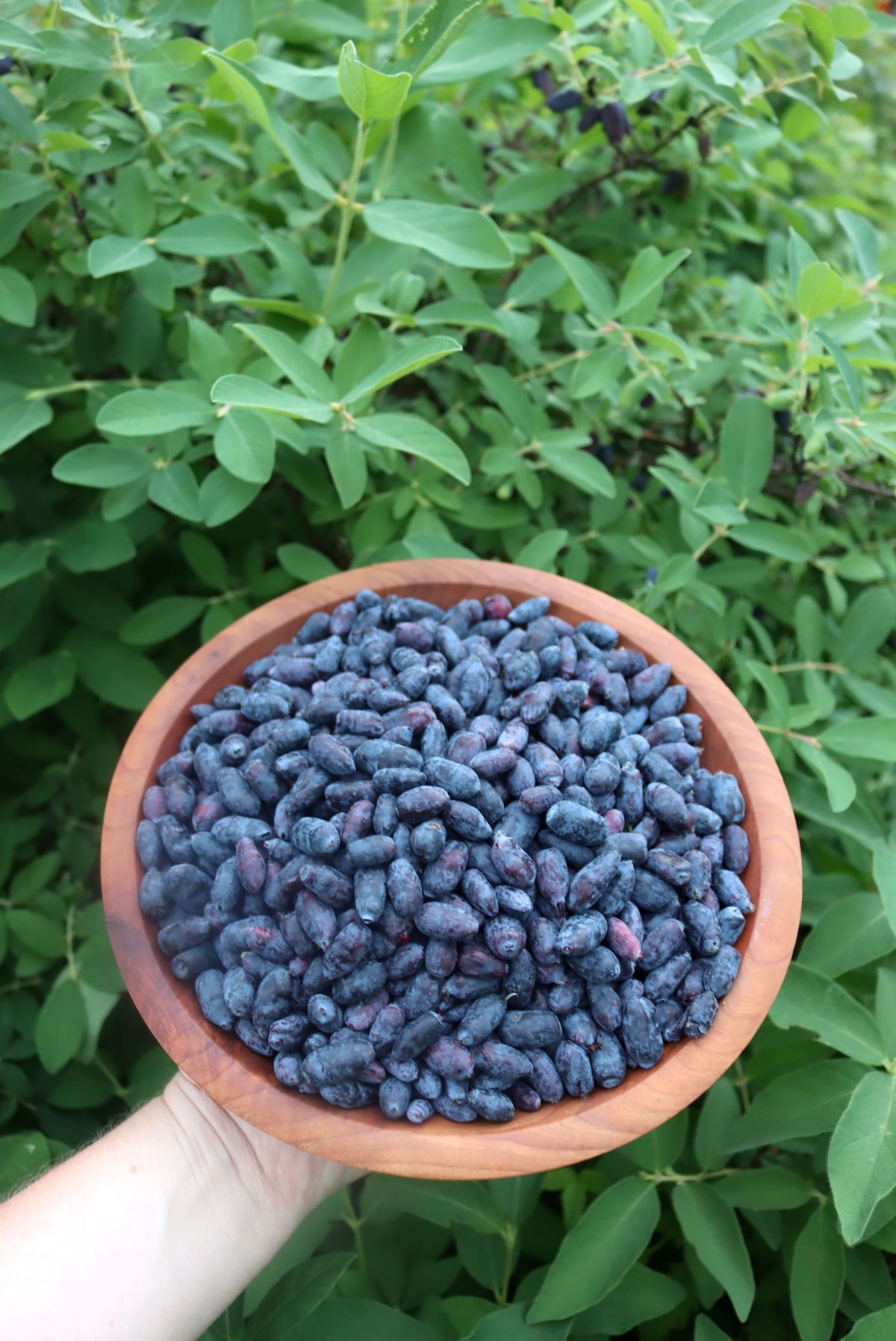
I’ve assembled this recipe assuming the reader is already aware of basic winemaking terms and techniques. If you are newer to winemaking, need a brushup, or just want to learn more about any subject in particular, these guides will be quite helpful to you:
- Beginners Guide to Making Fruit Wines is essential for anyone new to making fruit-based wines. Here I’ll take you through all the steps in the winemaking process.
- How to Make Mead (Honey Wine) will be quite similar, but there are some intricacies working with honey you should know about when making mead.
- Equipment for Winemaking outlines all the durable equipment you’ll need to make your first batch (besides your ingredients).
- Ingredients for Winemaking covers all the other things that you’ll need (other than yeast).
- Yeast for Winemaking is a world all of its own. There are dozens of common strains and hundreds of obscure ones. Since picking the right one is pretty important, I’ve broken them all down for you here.
Ingredients for Haskap Wine
Before beginning your wine, you’ll want to round up a few ingredients.
If you’d like to understand more about the purpose of each ingredient here or what possible substitutes you can use for them, I recommend you read this little primer on winemaking ingredients.
To make a one-gallon batch of haskap wine, you will need:
- 3 lbs haskap fruit
- 1-¾ lbs sugar
- 1 tsp Yeast Nutrient
- ⅛ tsp Wine Tannin
- 1 tsp Pectic Enzyme
- A handful of oak chips (to be added in secondary)
- Wine yeast
- Water to fill
You’ll need to gather about 3 lbs of fresh or frozen haskap fruit for a single-gallon batch of haskap wine. In addition to this, you’ll need about 1-¾ lbs of sugar or 3 lbs (1 quart) of honey if you’re making haskap mead.
Haskap berries are acidic enough on their own that you won’t need to add an acid blend. They have some tannins already so you’ll need to add just ⅛ a tsp.
As haskap berries do contain pectin, you’ll also need 1 tsp pectic enzyme to help the wine to clear.
You’ll also require a wine yeast and a small packet of yeast nutrient.
There are plenty of options available for wine yeast, depending on the style of wine you’d like to create. Some nice choices include Lalvin 71B, Zymaflore VL2, W15, Lalvin K1-V1116, Laffort F33 and Zymaflore VL1.
Know that the stronger the fermenter and higher the alcohol tolerance, the dryer your wine will be. Those with lower alcohol tolerances will produce sweeter wines.
Lalvin 71B has an alcohol tolerance of around 14% resulting in a nice sweet wine. Lalvin K1-V1116 is a stronger fermenter with an alcohol tolerance up to 18%, leading to a drier wine.
Zymaflore VL1 has an alcohol tolerance up to 14.5% while Zymaflore VL2 has an alcohol tolerance of about 15.5%. Laffort F33 and W15 both have an alcohol tolerance up to 16%.
A handful of oak chips is also recommended to give the wine more complexity (as well as improve texture and tannin profile).
These basic winemaking ingredients aren’t all you need before beginning your first batch of haskap wine. The following equipment will also be necessary:
- One-Gallon Wide Mouth Fermentation Vessel for primary fermentation
- One-Gallon Narrow Neck Glass Carboy for secondary (often sold as a kit with a rubber stopper and water lock together)
- Rubber Stopper and Water Lock (if not included above)
- Brewing Siphon
- Wine Bottles or Flip-top Grolsch bottles
- Bottle Corker and clean, new corks for bottling the wine
- Brewing Sanitizer
In the pictures here, I’m making a small batch in a half gallon mason jar, equipped with Mason Tops silicone fermentation valves. It’s the same equipment you’d use to make sauerkraut, and it works wonderfully with standard mason jars. That’s a good way to get the job done if you don’t have (or want to buy) a lot of home winemaking equipment. (The recipe below is written as a full-gallon batch recipe, but it an be halved or increased as much as you like for the batch size that works for you.)
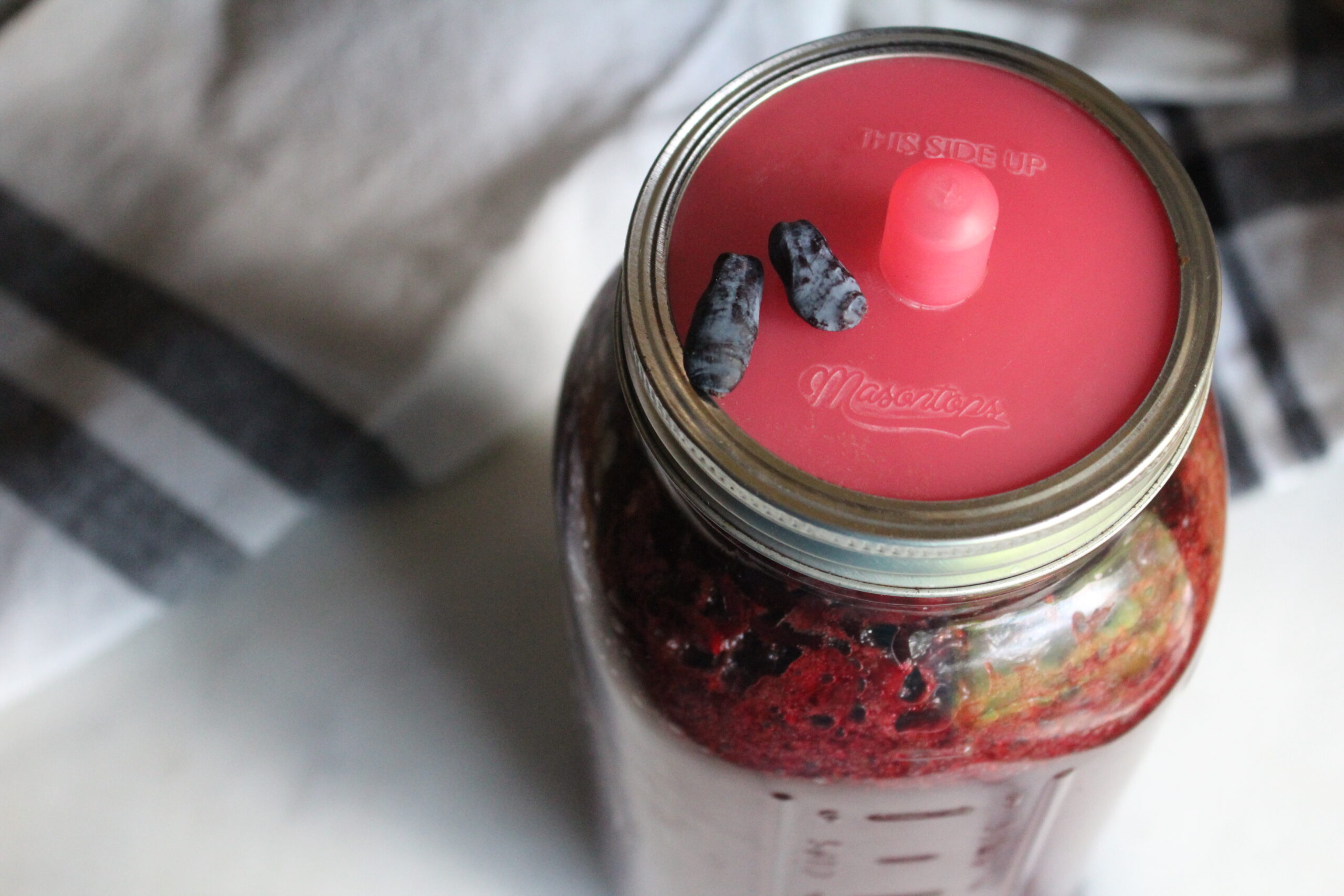
Making Haskap Wine
To make haskap wine, you’ll start by crushing the fruit. You can do this directly in your fermentation vessel (preferably a wide-mouth carboy) or place the fruit in a brew bag for simpler cleanup.
After placing the crushed fruit in your fermentation vessel, heat a few quarts of water on the stovetop. Add in the sugar and stir until dissolved. Pour over your crushed haskap berries and allow it to cool to room temperature.
Add the wine tannin, pectic enzyme and yeast nutrient next. The wine yeast should be added last.
Pitch the yeast by rehydrating it in a small bit of room temperature water for 10 minutes before adding. (Adding it directly to your carboy can shock the yeast.)
Add enough water to leave 2 inches of headspace in your wide-mouth carboy and seal with a water lock.
You should begin to see a nice bubbling fermentation in the next 24 to 72 hours. This is where the most active fermentation will take place.
Allow the wine to ferment in primary for about a week.
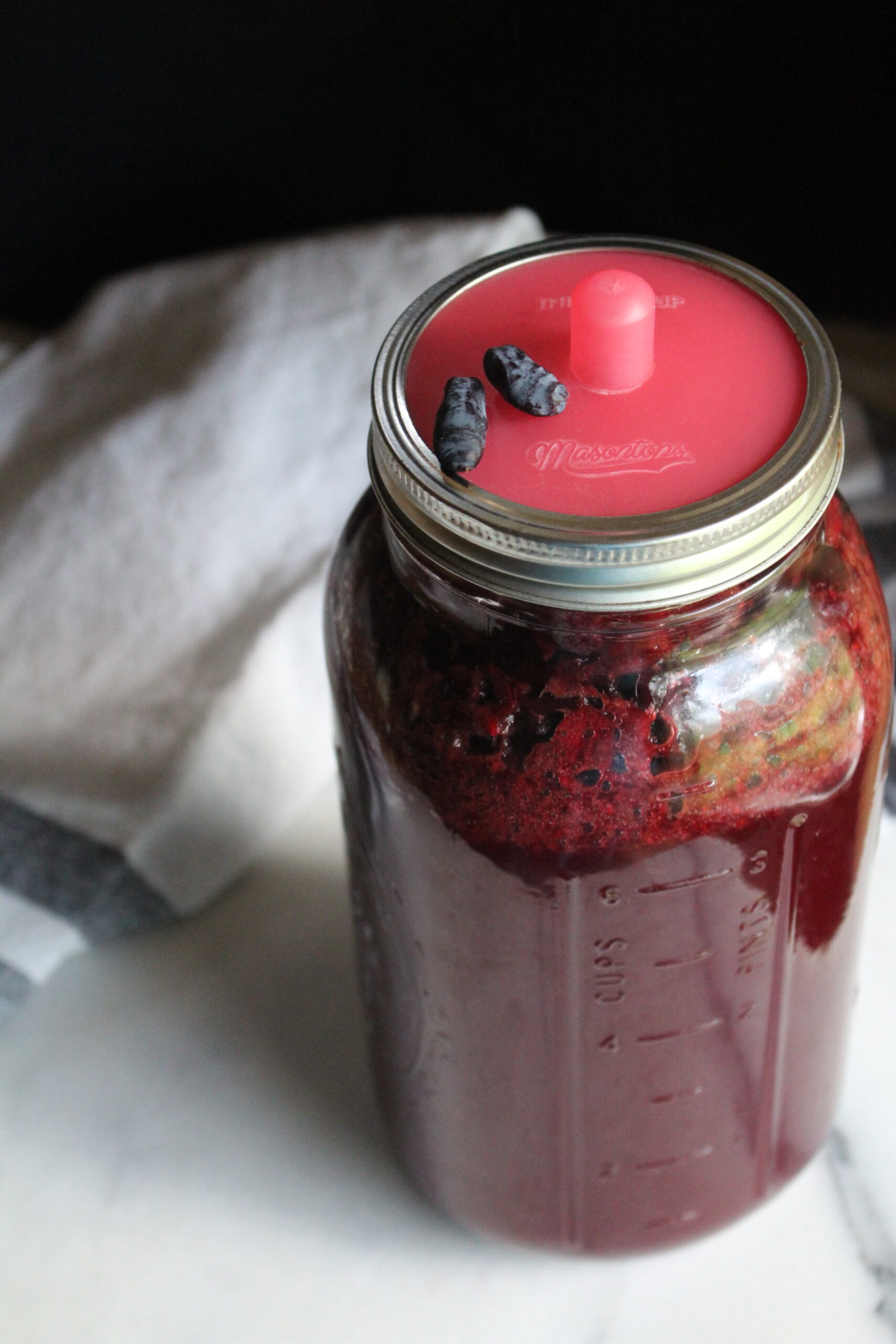
Next, siphon to a clean fermentation vessel for secondary, leaving the sediment behind and discarding the fruit. Now is when you can add in the oak chips.
Top up with water to bring the water level to the neck of the carboy and seal with a water lock. Ferment in secondary for at least 4 weeks.
If making haskap mead the time spent in secondary will be longer (anywhere from 2 to 6 months). Honey wine takes longer to ferment than regular sugar since honey is less digestible for the yeast.
Taste your wine at the end of secondary. If it seems too dry, you can always backsweeten. Rack your wine to a clean vessel before backsweetening and stabilize the wine before adding any sugar.
To stabilize, add 1 Campden tablet and ½ teaspoon potassium sorbate and wait 24 to 48 hours to ensure the yeast has died off. Add sugar in the form of a simple syrup and put it back into ferment for a week before bottling. If you’d prefer not to stabilize your wine, you can always backsweeten and put it back into ferment for longer (about a month) and bottle when all signs of fermentation have died off.
Once you’ve bottled the wine, let it age for at least a month. Wine always improves with age, so if you can wait longer, the flavor will only get better.
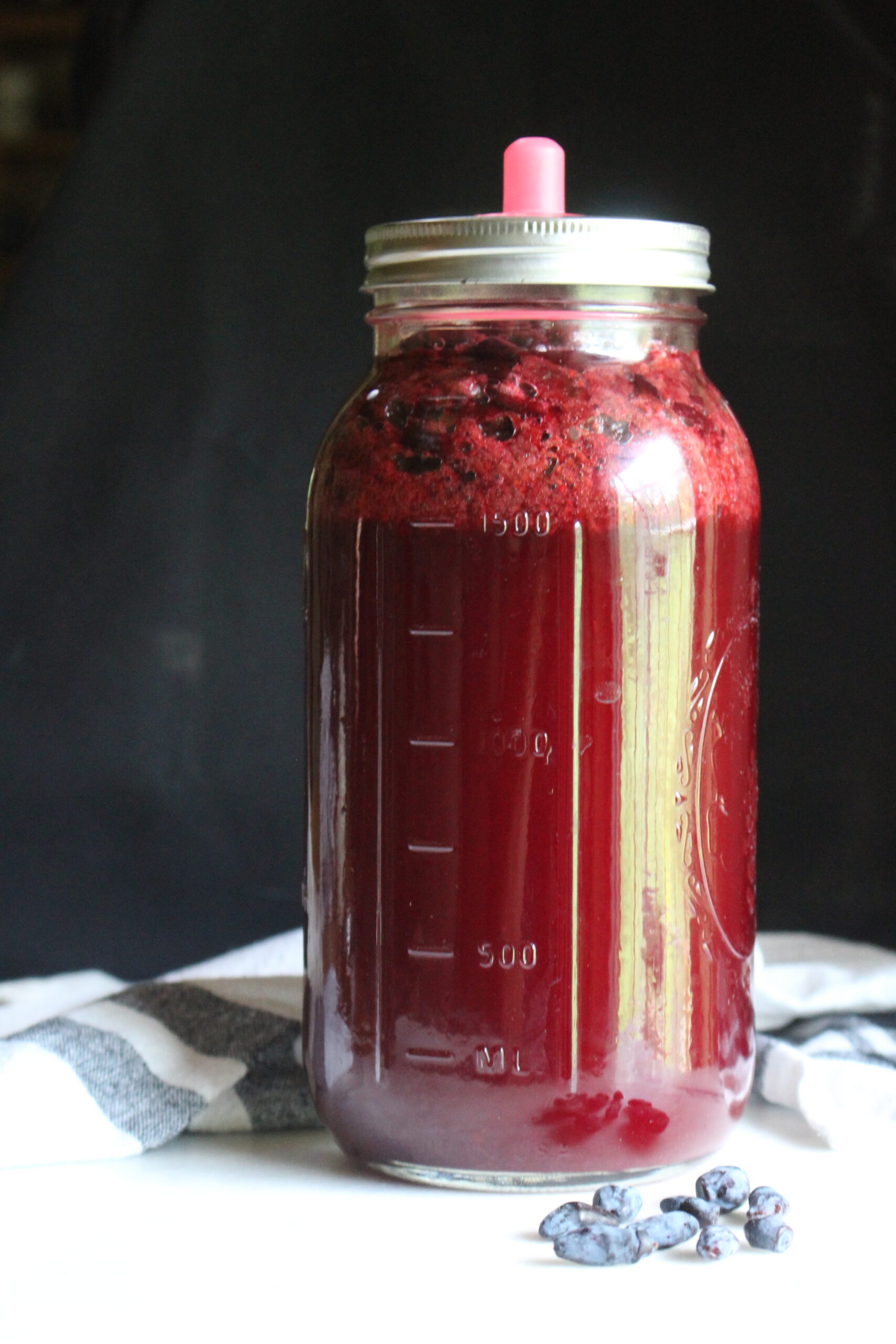
Ways to Preserve Haskaps
In search of more ways to use or preserve haskaps?
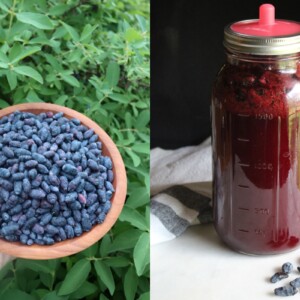
Haskap Wine (& Mead)
Ingredients
- 3 lbs haskap fruit
- 1-¾ pounds Sugar, about 2 cups per pound
- 1 tsp yeast nutrient
- 1 tsp Pectic Enzyme
- ⅛ tsp tannin powder
- wine yeast, see note
- 1 handful of oak chips
- Optional ~ Campden Tablet and Potassium Sorbate for Stabilizing, I do not use these
- Water, to fill
Instructions
- Crush the fruit and move to your primary fermentation vessel. Place the fruit in a brew bag, if desired.
- Heat a few quarts of water on the stovetop. Add the sugar and stir to dissolve.
- Pour the water over your crushed haskap berries. Let cool to room temperature.
- Add the wine tannin, pectic enzyme and yeast nutrient.
- The wine yeast should be added last. Pitch the yeast in a small amount of room temperature water for 10 minutes before adding to the carboy.
- Fill with enough water to leave 2 inches of headspace and seal with a water lock.
- Ferment in primary for about a week.
- Siphon to a clean fermentation vessel, discarding fruit and leaving sediment behind.
- Add the oak chips to your secondary ferment.
- Top with enough water to bring the level up to the neck of the carboy and seal with a water lock.
- Ferment in secondary for at least 4 weeks. For mead, time in secondary will be longer (2 to 6 months).
- Sample the wine at the end of secondary and adjust to taste as needed. See notes for backsweetening.
- Bottle the wine and seal with wine corks.
- Let age for at least a month before drinking, preferably longer.
Notes
Haskap Mead
To make haskap mead, substitute 3 lbs (1 quart) honey for sugar. Note that the time spent in secondary will be longer (2 to 6 months) as honey takes longer for the yeast to digest than sugar.Yeast
For haskap wine, choose a wine yeast with moderate alcohol tolerance for a sweeter wine or a higher tolerance for a drier one. Good yeast choices include Lalvin 71B, Zymaflore VL2, W15, Lalvin V1116, Laffort F33 and Zymaflore VL1. See notes within the article for the specific qualities of each yeast.Stabilizing and Back Sweetening
If the wine tastes too dry at the end of secondary, you may backsweeten. Rack the wine to a clean container first, then stabilize the wine by adding 1 Campden tablet and ½ teaspoon potassium sorbate. This will kill off the yeast, preventing a rapid ferment once the additional sugar is added. (This rapid fermentation can cause bottled wine to burst under the pressure.) After stabilizing, sugar can be added to taste. Make a simple syrup of equal parts sugar and water by heating and then add to the wine before bottling. Amounts needed vary by taste but beginning with ½ cup of sugar for one gallon of haskap wine should be enough. See notes within the article for more information regarding stabilizing and back sweetening.Spring Winemaking Recipes
Are you thirsty for more winemaking recipes? I have one for nearly every fruit out there (and some flower and veggie wines as well).
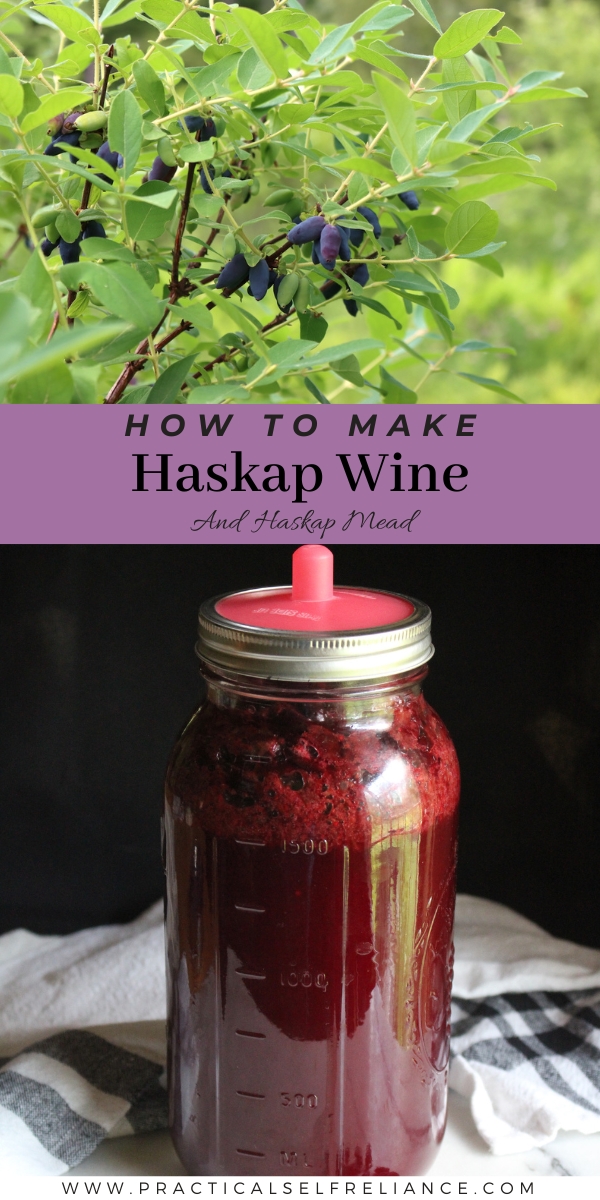


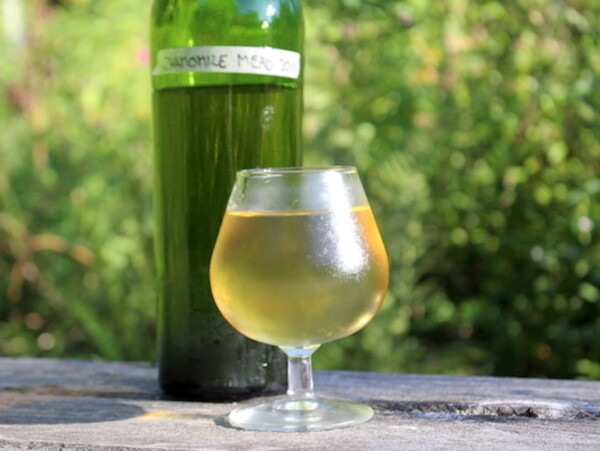
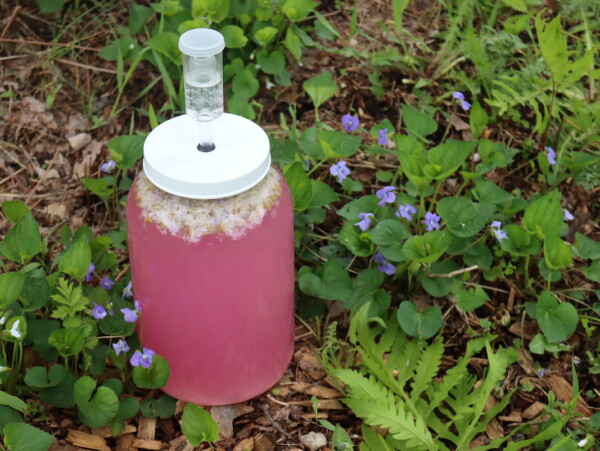










One of the best ways to get a “red wine” experience when you live in the frozen north where grapes don’t thrive. Haskaps truly make a wonderful wine.